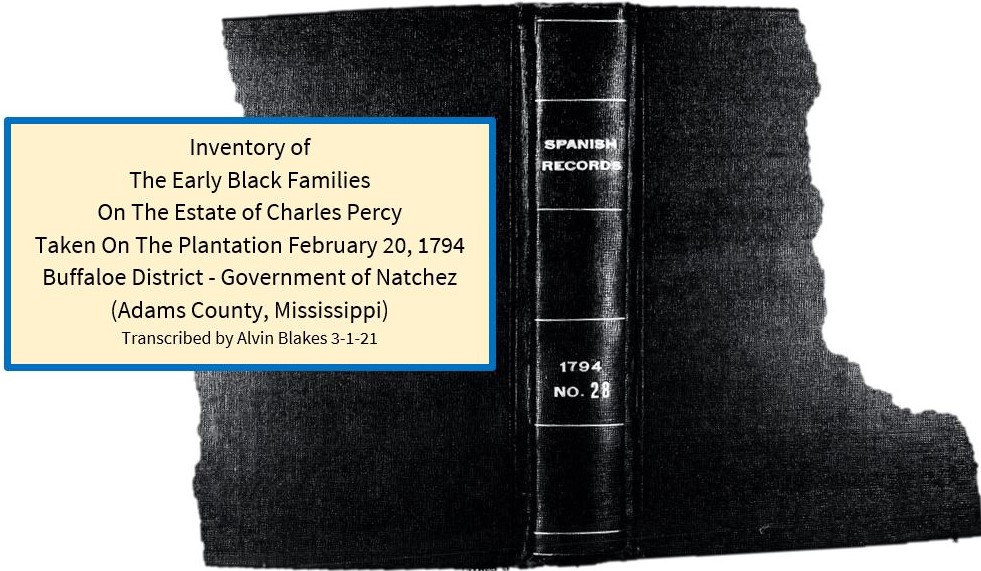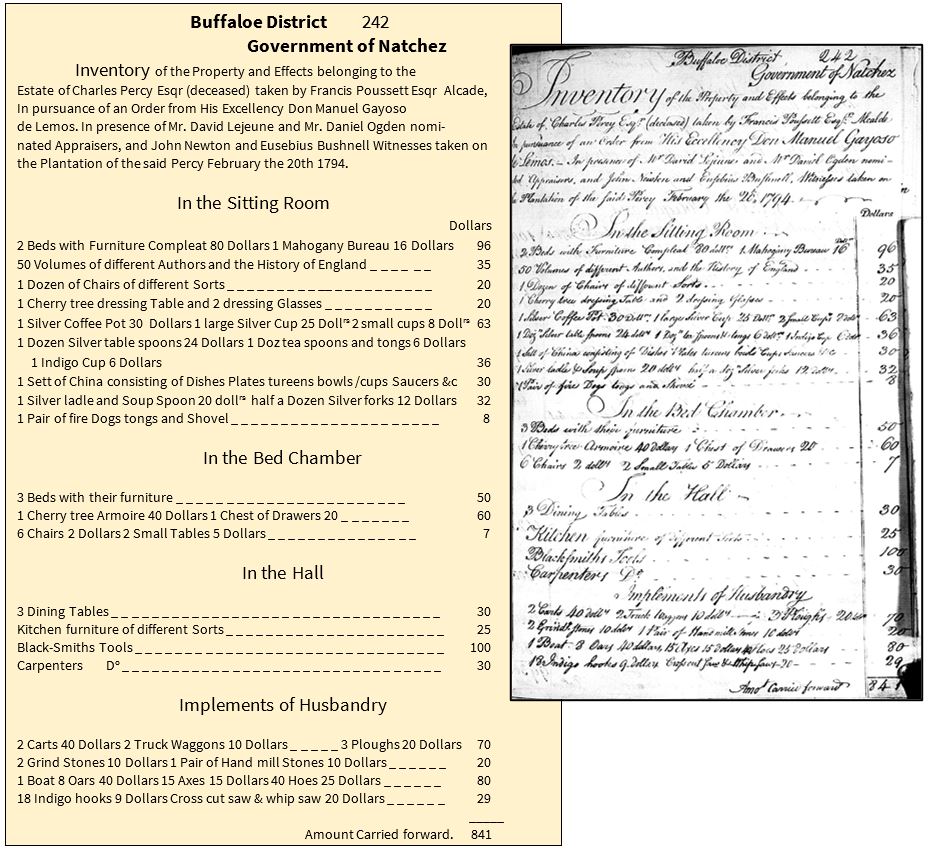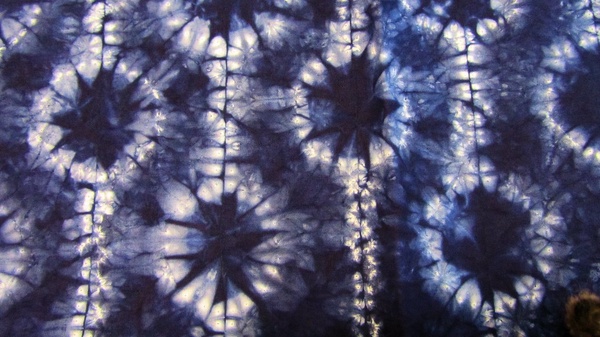Part 3. Inventory of the Black Families 1794
After the death of Charles Percy on January 30, 1794 an inquiry was held, and his death was officially ruled to be a suicide. On February 20, 1794 his neighbors and friends were assembled to witness and appraise the inventory of his estate, which included all the people he had enslaved. His wife Susanna Collins and his minor children were the benefactors of his estate.
In the 17 years since Percy arrived in Woodville in 1777, the lands were acquired, and Africans were purchased to clear the land of trees, cut the roads, plow and plant the crop, and build the houses and structures into profitable plantations. Some of the families purchased by Percy were already in the Natchez Region and may have been separated from their families and recently brought into the area from Virginia or the Carolinas. Some were brought in with Percy from either North Carolina, St. Eustatius Island, Florida or New Orleans and likely were separated from family members. Others, purchased in New Orleans, had recently been uprooted from Africa and the Caribbean. In this short 17-year span, new families were reassembled and began living shared lives while working the plantations.
The death of a plantation owner could be a scary and worrisome time for the Black Plantation Community. The fate of the newly formed community was tied to the inventory and settling of the Estate. If there were debts to be paid, many of the enslaved would be auctioned off and sold, leaving many families split up again.




A Few Notes/Observations on the 1794 Inventory (A. Blakes)
- Family “households” are listed with the given name and age of the husband, wife, and children, followed by the assigned dollar value of the family or individuals. The amount the person was valued at was in proportion to their age. Older persons were valued less, as their ability to do hard labor lessened with age.
- The abbreviation “Do” is short for Ditto, meaning same as above.
- The Black Family Plantation Community has grown to 55 people valued at $11,970.00. 21 (40%) are children 10 years old and younger; 5 were newborns only a few months old.
- Names shown in red are recognizable from the table in Africans Purchased by Charles Percy in Louisiana 1787-1793 in Part 2. The ages are also now revealed in the inventory.
- The oldest persons Burrows and Cork at 60 years were born in 1734; Christmas at 55 years was born in 1739; Hamlet, Cato & Sarah at 50 years were born in 1744.
- The name Quaquo is a derivation of the name Kweku/Kwaku/Quaco, an Akan name from Ghana, West Africa, that was given to boys born on Wednesday. He is 25-years old, born in 1769, and his name does not appear again in the plantation documents.
- The Africans living in the “Negroe Cabbins” probably had their own names or nicknames. The names given them by the plantation owner was to identify them as his property.
- The main “cash crop” encouraged by the Spanish government in 1794 was Indigo. The indigo plant was processed into a dark blue dye and exported to Europe. In The House Of Percy Bertram Wyatt Brown states, “The necessary pair of vats and other equipment alone cost 1000 or more dollars, not to mention the outlay for a sizable slave force. It was also a risky enterprise with widely fluctuating prices. Still worse, preparation of the dye involved processes that attracted flies to the vats, poisoned the wells and streams so that cattle losses were also high, and most serious of all, spread sickness and death among the slaves.” Indigo production and overwork likely killed many of the early Africans on the Percy Plantation and it poisoned the environment.
Indigo Production & Use
Clockwise left to right
- indigo plant
- underground indigo dye vats
- African indigo tie-dyed fabric
- blue jeans dyed with indigo
Before any major decisions could be made on the Estate, Percy’s wife, Susanna, died in 1803. This required another Probate be opened so that the estate could be divided among the Percy children.
Next: Inventory of the Black Families 1804





Thank ya keep up the great work Ser Boxley
You too my Brother. Stay strong and continue to walk thru life unafraid!
Good read. Keep them coming.
Thanks for reading Marlon.
I am enjoying and keep it coming.
Thanks for reading.
Amazing research and finds! The inventory listings blew my mind. I wonder if any indigo plants still exist on the land. Our ancestors harvested the “blue” in blue jeans. WOW!
Ramona thanks for reading. I don’t know if indigo still grows in the wild.
Fascinating work-again. Im wondering who fathered the mulatto children mentioned. I also wonder if Patrick Foley, listed as debt owed is related to Hugh Foley.
Gerri thanks for reading. I know that Hugh Foley was a prominent Black Reconstruction era politician in Wilkinson County, but I don’t know his relationship to Percy’s neighbor Patrick Foley.
Great read, Alvin!
I don’t recall ever hearing of plantation owners committing suicide. I wonder why he made that decision. It doesn’t seem like but was there any indication that he owned a major debt?
It is fascinating that his property, right down to the pieces of furniture, was listed in his will as though his wife had nothing to do with “their” property.
Keep up the good work.
Vernita thanks for reading. Percy’s Estate had no debt – just the opposite. In the book The House of Percy: Honor, Melancholy, and Imagination In A Southern Family that I discussed in Part 2 of this blog series, Melancholy” is in the title as a nice way to say depression and suicidal tendencies were a family trait. It will be discussed about another Percy family member in an upcoming blog. Also, in 1794, plantation wives generally had no say-so in matters such as property rights.
Hello cousin. Another major find about the life and times of our ancestors. These docs are priceless. As I read on, a feeling of sadness and disdain overcomes me. A feeling that always arise when I read or view a movie about those brutal times that our people endured. However, I am honored to have such vast knowledge about our town and I appreciate your hard work and dedication to our history.
Jackie thanks for reading.
This history is very Informative. My family, the Glasper’s moved to percy creek after a great flood on Lake Mary. They relocated there from Jimmy Lee island around Buffalo and Jackson Point. I never knew why it was called Percy creek. Thanks
Vanessa thanks for reading.
Fascinating history. Well organized for interpretation. Great work Blakes. Master teaching through example.
Thanks Mayo.